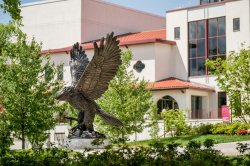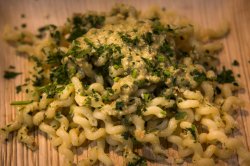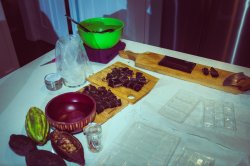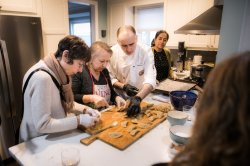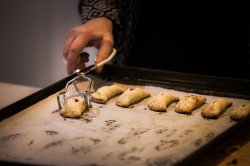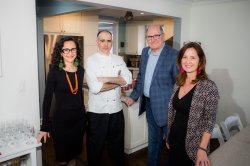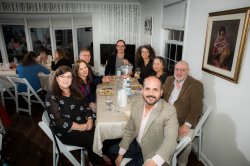Gastronomía Is Just an Accent Away from Gastronomia: A Cooking Workshop and Tasting about Spanish and Latin American Influences on Italian Dishes
Posted in: CHSS News, Inserra Chair Events, Italian News and Events
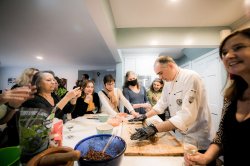
Why is Aztec chocolate produced in Sicily? How did potato croquettes arrive in Southern Italy? These were some of the questions at the heart of a cooking workshop and tasting entitled “Gastronomía Is Just an Accent Away from Gastronomia: A Cooking Workshop and Tasting on Spanish and Latin American Influences on Italian Dishes” that took place in Montclair, NJ on March 26, 2022. Offered by the Inserra Chair in Italian and Italian American Studies, and organized by Teresa Fiore (Inserra Chair) and Federica Heiman, the event featured the Italian chef Giuseppe De Falco and wine educator Hank Zona. The menu was designed with chef Annalisa Pompeo of Go Sicily with the idea of combining foods whose core ingredients were brought from the Americas by the Spaniards or whose preparation was affected by the Spanish presence in Italy, which covered a vast geographical area (from Sicily to Naples, Sardinia and Milan) and a long historical period (between the 1500s and the 1700s, if not longer for certain regions, as the Spanish dynasties mixed Aragonese, Castilian and Bourbons governing families over time).
Chef Giuseppe De Falco (about to open a new restaurant in Montclair called Stazione Antica) prepared four dishes influenced by the Spaniards. The guests, a group of professors, alumni, and administrators from Montclair State University along with local high school teachers, art historians, writers, and former city officials, started by savoring a delicate caponata – a bittersweet eggplant-based dish which is served cold. Its origin has spurred a significant debate but its inclusion in the menu of aristocratic families during the Spanish era is well documented. The version we normally eat today, often devoid of fish, is a poorer translation of their dish, but rich in flavor nonetheless.
Potato croquettes were fried on the spot and served warm. Known as “cazzilli” in Sicily, these breaded mashed potato-based cylinders sprinkled with mint are street food par excellence. Again the origin is up for grabs but the very ingredient at the heart of it – the potato – was brought by the Spaniards from the Americas, and it became a staple of many basic dishes such as the Spanish tortilla. The main dish was busiate al pesto trapanese, a typical pasta from Western Sicily dressed with a sauce made with almonds, garlic, fresh tomatoes, basil, and pecorino.
The protagonist of the evening was mpanatigghi, an original dessert still made in Modica, Sicily, whose name is a local adaptation of the word “empanadas” with which it shares the shape and general concept (dough with a filling). Interestingly, this version is a sweet containing chocolate and spices, as well as…, surprisingly, minced meat. According to one story, originally the nuns would make the mpanatigghi for monks proselytizing around the countryside during Lent. And while meat was not allowed by the Catholic calendar at that time of the year, they secretly introduced some animal proteins in the filling to help them cover long distances by foot. The preparation on March 26 in Montclair was the occasion to involve the participants with their “hands in the dough” (an expression that in Italian means to be part of something in deep ways… even to control internal affairs!).
Pairing wine with food is not just a technique but also an opportunity for storytelling, especially in the hands of Hank Zona, creator of Grapes Unwrapped. Intertwined with family anecdotes and data about wine production across countries, the Cerasuolo di Vittoria (the only DOPG in Sicily) and the Grillo wines were illustrated by Zona for their characteristics as much as for the role they have played in the blossoming Sicilian wine landscape.
The event closed with Federica Heiman (Montclair-based chocolatier and owner of Dolce Federica), who offered a live demonstration of the preparation of the Aztec chocolate, a bar made with cocoa paste and sugar, with no added butter, and quite grainy in texture thanks to a low melting temperature. Originating from the Aztec Empire, the recipe traveled across the Atlantic along the commercial routes of the Spanish Empire. Today this bar is used for hot chocolate in Mexico and among the Latin American communities around the world, while it is eaten in chunks in Italy and wherever Italian products circulate.
The workshop/tasting were part of a broader research project, Memoria Presente: The Common Spanish Legacy in Italian and Latin American Cultures, directed by Dr. Teresa Fiore and aimed at the ongoing development of an open access digital archive with multi-disciplinary materials (films, novels, images of art and architecture) telling the story of these cultural encounters. Supported by an NEH grant, the project has already inspired a film screening and discussion about Chilean refugees in Italy in the 1970s (Santiago, Italia) as well as another two workshops on Aztec chocolate and Teaching Italian for Spanish speakers in the high school and university systems. The overall goal is to highlight commonalities and shared experiences between Italy, Spain and Latin America, often so close that just a written accent distinguishes them, as in gastronomia/gastronomía.
Left image (from left): Teresa Fiore, Giuseppe De Falco, Hank Zona, Federica Heiman
Right image (from left clockwise): Montclair State University professors and administrators, including new Provost Junius Gonzales (upper left corner) and Katia Paz Goldfarb (Associate Provost, Hispanic Initiative – lower left corner), along with high school teachers and food travel operators
Special thanks to the Inserra Supermarkets for providing the ingredients.
For more information about the event, see dedicated webpage.
For more information about the Cuisine section of the Memoria presente digital archive, click here and use the password NEHFiore2021
For the full set of photos by Arpi Pap Studio Images, see gallery.
